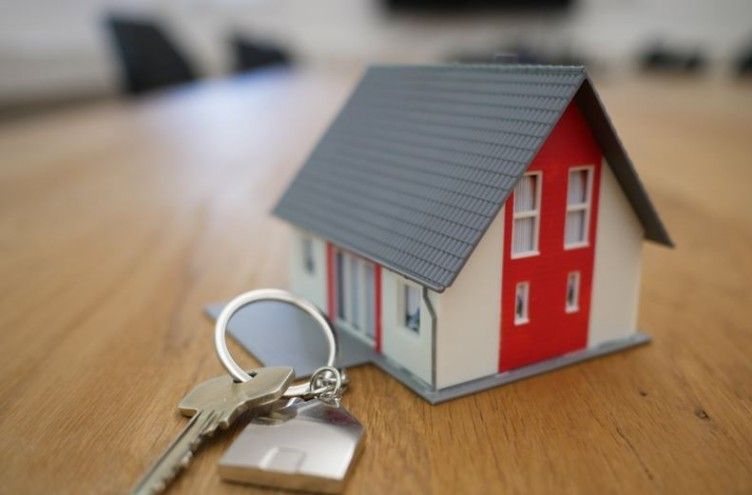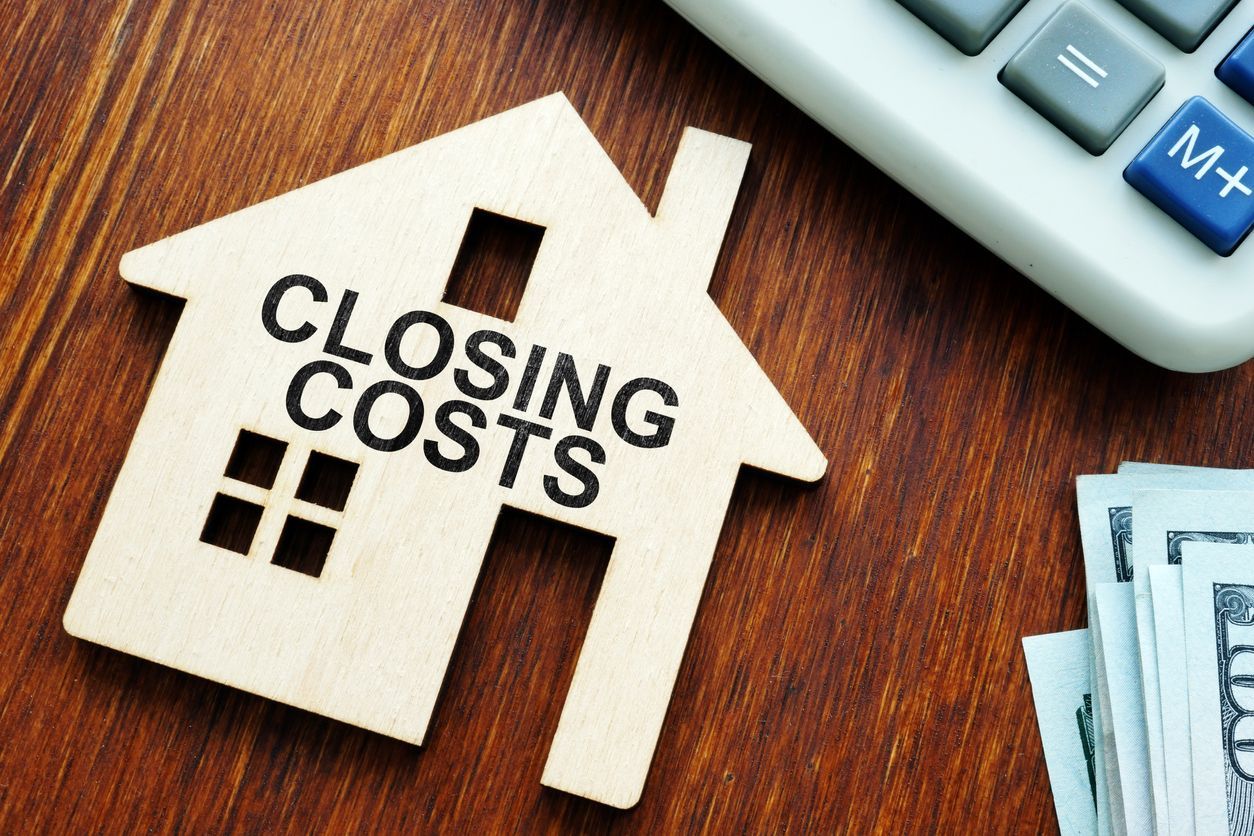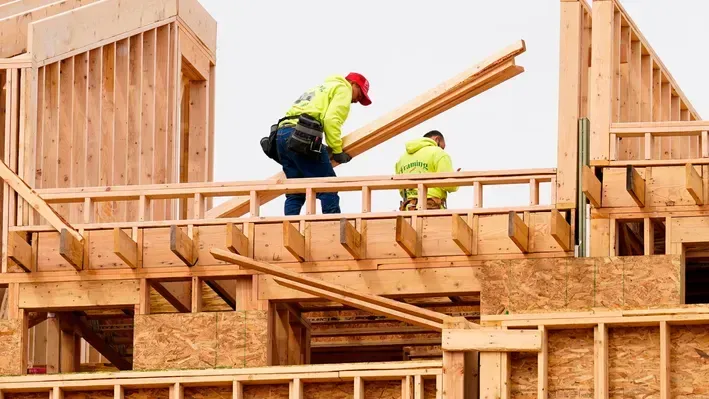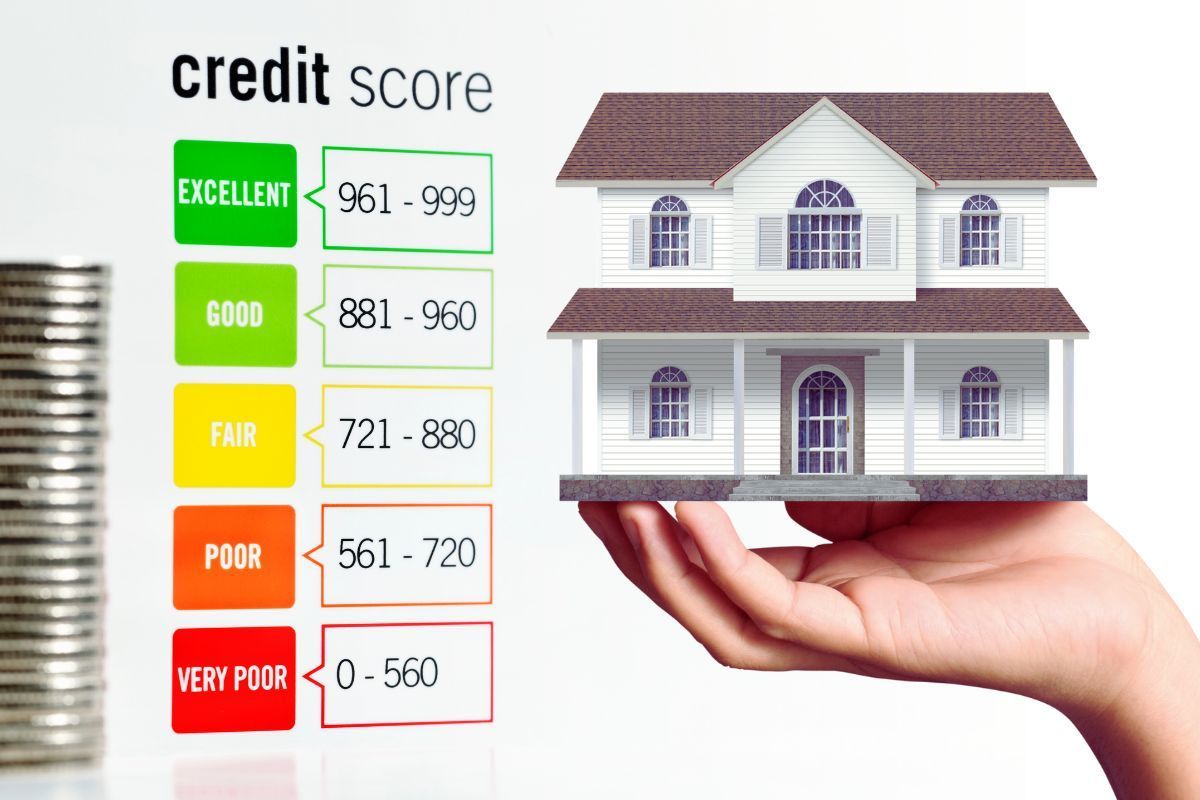Contact Us
Contact Us
Contact Us
Contact Us
16 first-time homebuyer mistakes to avoid
Ralph DiBugnara • March 20, 2025

The body content of your post goes here. To edit this text, click on it and delete this default text and start typing your own or paste your own from a different source.
SHARE ON

By Julie Gerstein October 22, 2025 Real Estate Is Still a Good Investment: How It Stacks Up Against Gold, Bitcoin After soaring to new highs just as the U.S. government entered its first shutdown in almost seven years, gold prices slid back down by just over 5% on Tuesday to around $4,130. Some experts still look at the precious metal as a solid investment, while others warn this is why investing in assets like real estate is a smarter move. Though high mortgage rates are making it more expensive to buy a home right now, many experts still believe that real estate beats out other investment opportunities. And with President Donald Trump signing an executive order allowing alternative assets such as private equity, cryptocurrencies, and real estate into workplace retirement plans, the market is still a better investment. In fact, according to Gallup, 37% of Americans still agree that real estate is the best long-term investment, with only 23% saying gold and 16% relying on stocks. If all of these options leave your head a bit scrambled about where to put your money, you're not alone. Some areas of investment, like art, require specialized knowledge, while others depend on how much risk you're willing to take. With real estate in particular, many homeowners are sitting on record-high equity, which can be used through a home equity loan or a home equity line of credit (HELOC) to purchase an investment property, according to Hannah Jones, senior economic research analyst at Realtor.com®. "However, investing in real estate is not a slam-dunk in all markets as high home prices and elevated mortgage rates squeeze potential earnings," she points out. "Investors, or homeowners looking to branch out into buying an investment property, should fully understand expected cost and expected income from a property, as well as the time horizon to see a profit." Here's how real estate stacks up against other investments. Buying real estate Pros: Real estate values have grown at a slower pace than the S&P 500 on a year-over-year basis, but according to a Realtor.com analysis, real estate saw an average five-year return of +26% since 1975 as of the end of 2024. That's nothing to sneeze at. Typical homeowners have also accumulated at least $147,000 in housing wealth in the past five years, according to the National Association of Realtors® in its fourth quarter of 2024 report. "Traditional investments like 401(k)s, IRAs, and ETFs are great for passive growth, but real estate brings in a whole different level of wealth-building," says Dan Reedy, a real estate investor and broker. Real estate is also a much more hands-on investment. "With real estate, you can actively influence your returns by making strategic upgrades or managing rental rates," he adds. "Plus, real estate offers deductions—mortgage interest, depreciation—that can make a huge difference come tax season. It's not just about growing wealth; it's about growing wealth you can control." Sara Levy-Lambert, vice president of growth at real estate management company RedAwning, adds that although real estate is not without risks, its "blend of passive income potential, stability, and the chance to build equity over time make it a solid choice for those looking to diversify beyond paper assets." Cons: If you value liquidity and being able to access your funds at a moment's notice, it's probably not the right move for you. Buying and selling homes can take months—if not years—and can require a lot of upfront costs. "The biggest problem I see is that people have record equity in their home right now—more than they've ever had before. But that's just a number on paper," says Ralph DiBugnara, founder of real estate resource site HomeQualified. "You can't really do anything with it unless you're willing to take [money] out of the house, unless you're willing to leverage it." By that, DiBugnara means being able to leverage a home equity loan or home equity line of credit. Investing in real estate directly "gives you full control—you decide on tenants, renovations, and how it's managed. But you also take on the costs and responsibilities that come with ownership," says Jace Graham, CEO of Rising Phoenix Capital. Real estate investment trusts Pros: When you think of real estate investing, you're likely picturing putting a down payment on a home and negotiating the terms of a mortgage. But if you can't afford to build a personal portfolio of investment properties, that shouldn't discourage you from buying into the market. Many do so by participating in real estate investment trusts, or REITs. REITs allow investors to buy shares in a real estate company. Their portfolios typically include a mix of residential and commercial properties. "You don't own the property directly, so you're hands-off, which is easier for most people," Levy-Lambert says. "They're also traded like stocks, making them more liquid. Just buy or sell whenever you want, without the management headaches." The IRS requires REITs to pay out at least 90% of their income as dividends to shareholders, so investors have a steady flow of funds coming in. It's also taxed as regular income. "In a nutshell, direct real estate gives you control and potential tax perks but requires more work and patience, while REITs offer easy, flexible access to real estate returns without the management hassle but are taxed a bit differently," says Levy-Lambert. A REIT also might be a great place to start if you haven't saved up enough for a down payment but want to make a steady return on the market. Cons: REIT dividends are generally taxed as ordinary income—not at the lower capital gains rate. The average annual dividend yield for publicly traded REITs currently hovers around 4%, though this can vary by sector and market conditions. Cryptocurrency Pros: There's big money to be made—or lost—in the cryptocurrency market at the moment. Bitcoin initially traded at $0.00099 in 2009, but today it's over $88,000, and early investors who have held on have made many millions of dollars. The current presidential administration is also very invested (pun intended) in making crypto more accessible. Cons: Of course, investing in cryptocurrency comes with many risks. Aside from the many crypto-related scams, including the spectacular collapse of Sam Bankman-Fried's FTX, you might need nerves of steel to play in this market. "Cryptocurrencies are notoriously volatile, subject to speculation, and witness frequent bubbles and crashes," says Harry Turner, founder of Sovereign Investor. "That's why cryptocurrencies are really only suitable for individuals with a high risk tolerance and an understanding of the underlying technology, which can be complex. Real estate doesn't have this problem." Gold Pros: These days, you can purchase gold stocks or ETFs, or buy the physical stuff—coins and gold bullion. If that's what you're into, you can even buy gold at Costco now. For some, nothing beats the security of owning a chunk of precious metal. Gold is a relatively stable asset. It's less reactive and can be a good hedge against the volatility of the market. In the four years following the 2008 financial crash, the price of gold increased dramatically—in 2011 alone, by 32.8%. Fast-forward to today, and the price of pot gold is on a bit of a roller coaster. After hitting an all time high price of $4,225.10 per ounce in early October, the prices started to plunge by the following week, falling as much as 6.3% soon after, marking the largest intraday drop for the metal since a 6.3% plunge in June 2013, according to Forbes. The strength in gold follows the implementation of many of Trump's tariffs on Aug. 8, including surprise levies on 1 kg and 100-ounce imported gold bars. The import charges on gold bars could disrupt shipments from primary refining hubs, including Switzerland, London, and Hong Kong. Cons: Though you can buy gold at Costco, you can't sell it through the store. In fact, it's fairly difficult to sell gold commercially—and you'll have to do a good bit of research to get a fair price. Let's be real: Physical gold weighs a ton, and it's not the easiest thing to move around. Plus, you’ll want to insure it, which will cost you additional money, and there are higher taxes on physical gold. So if you sell, you’ll have to pay a capital gains tax of up to 28% on any profit. (The typical capital gains on stocks and bonds is 20%.) Investing in other types of tangible assets Pros: Relatively niche markets allow investors to dig into the things they love, be it art, cars, or wine. Cons: There's a high barrier to entry in some of these particular markets—not just financially, but in terms of knowledge. For example, the classic car collectible market is fairly exclusive and, as an investment category, it might not be very practical either because every time you use one of these collectibles in your portfolio, you run the risk of lowering its value. Alternative assets can be exciting and sometimes profitable, but they come with extreme volatility. The wine market, for instance, is affected not just by the collector market but also by the agricultural outlook and weather conditions. These markets don't necessarily move quickly, either. As interest ebbs and flows in different types of asset classes, so do potential moneymaking opportunities. "Look at crypto. Bitcoin, for instance, went from $60,000 to $20,000 in under a year," says Reedy. "The occasional blue-chip wine or NFT might pay off big, but real estate lets you sleep at night while building long-term wealth." No matter what you choose to invest in, you should talk to your financial adviser about what types of investments are right for you. Dina Sartore-Bodo contributed to this report.

By: Ralph DiBugnara on October 8, 2025 First-Time Home Buyer Advice: Fourth Quarter 2025 By Paul Centopani Reviewed By Aleksandra Kadzielawski October 7, 2025 - 9 min read https://themortgagereports.com/122882/first-time-home-buyer-advice-q4-2025 Expert guidance for first-time home buyers The housing market can be a tough and sometimes confusing place to navigate — especially for first-time buyers. Home buying conditions are in a constant state of flux, shifting over time and by geography. Strained affordability pushed many prospective home buyers to the sidelines in recent times. However, conditions are improving in many places around the country. To gain insights and (hopefully) make matters easier, The Mortgage Reports spoke with industry experts to help guide borrowers in 2025’s fourth quarter. Answers may have been edited for brevity and clarity. This year’s fourth quarter market is different because of a combination of lower mortgage rates as well as a year of decreased real estate sales. Almost all markets have seen a reduction in homes sold compared to 2023 and 2024. Buyers have gotten priced out because of a lack of homes for sale and unaffordable payments based on elevated interest rates. In September, mortgage rates hit their lowest levels of 2025 and it’s starting to reignite buyers coming to market. That, plus an increase of refinances, means more cash to buy and gives a busy outlook for the quarter. Create a budget and stick to it. There are still not enough homes for sale to meet demand if mortgage rates drop much lower. The demand will increase and bidding wars will be upon us again. It’s important to not overpay for a house that isn’t yours out of fatigue from multiple rejected offers.

By: Ralph DiBugnara on October 8, 2025 First-Time Home Buyer Advice: Fourth Quarter 2025 By Paul Centopani Reviewed By Aleksandra Kadzielawski October 7, 2025 - 9 min read https://themortgagereports.com/122882/first-time-home-buyer-advice-q4-2025 Expert guidance for first-time home buyers The housing market can be a tough and sometimes confusing place to navigate — especially for first-time buyers. Home buying conditions are in a constant state of flux, shifting over time and by geography. Strained affordability pushed many prospective home buyers to the sidelines in recent times. However, conditions are improving in many places around the country. To gain insights and (hopefully) make matters easier, The Mortgage Reports spoke with industry experts to help guide borrowers in 2025’s fourth quarter. Answers may have been edited for brevity and clarity. This year’s fourth quarter market is different because of a combination of lower mortgage rates as well as a year of decreased real estate sales. Almost all markets have seen a reduction in homes sold compared to 2023 and 2024. Buyers have gotten priced out because of a lack of homes for sale and unaffordable payments based on elevated interest rates. In September, mortgage rates hit their lowest levels of 2025 and it’s starting to reignite buyers coming to market. That, plus an increase of refinances, means more cash to buy and gives a busy outlook for the quarter. Create a budget and stick to it. There are still not enough homes for sale to meet demand if mortgage rates drop much lower. The demand will increase and bidding wars will be upon us again. It’s important to not overpay for a house that isn’t yours out of fatigue from multiple rejected offers.

By: Ralph DiBugnara on October 2, 2025 By:Julie Gerstein on August 8, 2025 https://www.realtor.com/advice/finance/real-estate-investment-gold-bitcoin/ Gold is glittering in the headlines again. With prices hitting record highs in August—$3,534.10 per ounce, to be exact—many investors are wondering: Is now the time to pivot away from real estate and jump on the gold train? It’s a fair question. After all, gold has long been viewed as a safe haven, especially in times of uncertainty, and with new tariffs shaking up global markets, its value is soaring. But is it really the best place to put your money right now? Let’s break down how gold stacks up against other popular investments—including real estate, cryptocurrency, and alternative assets—to help you decide where your dollars belong. Real Estate: The Long Game Winner? Despite high mortgage rates and steep home prices, real estate continues to shine as a top long-term investment. In fact, a Gallup poll shows 37% of Americans still consider real estate the best long-term investment—more than gold, stocks, or crypto. Real estate’s appeal comes down to three things: Equity Growth: According to the National Association of Realtors®, homeowners gained $147,000 in housing wealth on average over the past five years. Tangible Control: You can actively influence your investment’s value through renovations, rental income strategies, and market timing. Tax Benefits: From mortgage interest deductions to depreciation, real estate offers meaningful tax advantages. "Traditional investments like 401(k)s, IRAs, and ETFs are great for passive growth, but real estate brings in a whole different level of wealth-building," says Dan Reedy, real estate investor and broker. And in 2025, there's a new twist: President Trump recently signed an executive order allowing alternative assets like real estate and crypto into workplace retirement plans, opening the door for more Americans to diversify their retirement portfolios. Still, real estate isn’t without its challenges. "You can't really do anything with [your home equity] unless you're willing to leverage it," explains Ralph DiBugnara, founder of HomeQualified. In other words, that equity is locked unless you’re willing to tap it via a loan or HELOC. Gold: A Glittering (But Limited) Hedge Gold has surged thanks to tariffs on imported bars and rising demand as a hedge against inflation and global instability. Pros: Stability during market downturns Hedge against inflation and currency fluctuations Physical ownership for those seeking tangible assets Cons: High taxes on physical gold (up to 28% capital gains) Low liquidity in physical form—selling takes effort No cash flow—unlike real estate, it doesn’t pay dividends or rent And while buying gold at Costco may be trendy, it’s not exactly practical when it comes time to sell or store it. Cryptocurrency: High Risk, High Reward Bitcoin is booming—again. At over $88,000, it’s hitting new highs. But the crypto market remains volatile and speculative, better suited to thrill-seekers and tech-savvy investors. "Cryptocurrencies are notoriously volatile... Real estate doesn't have this problem," notes Harry Turner, founder of Sovereign Investor. Crypto Pros: Potential for massive returns High liquidity Growing institutional support Crypto Cons: Extreme volatility Security and fraud risks Regulatory uncertainty REITs: A Middle Ground for Real Estate Investors Want to dip into real estate without buying physical property? Real Estate Investment Trusts (REITs) let you invest in real estate portfolios without getting your hands dirty. Pros: Traded like stocks—easy to buy and sell Regular income via dividends (up to 90%) Diversified across property types Cons: Taxed as ordinary income Less control compared to owning property directly Yields (around 4%) can vary by sector REITs are great for those who want exposure to real estate without needing a down payment or dealing with tenants. Tangible Alternatives: Art, Cars, Wine—and Complexity Yes, it’s possible to invest in fine wine, classic cars, or digital art (remember NFTs?). But these markets demand deep knowledge, significant capital, and often... luck. "The occasional blue-chip wine or NFT might pay off big, but real estate lets you sleep at night while building long-term wealth," says Reedy. Pros: Passion-driven investments Potential for high appreciation Cons: Illiquid and niche Highly dependent on market trends Often not recession-proof So, Where Should You Put Your Money? There’s no one-size-fits-all answer. But if you’re looking for steady growth, tangible control, and long-term stability, real estate continues to make a strong case—especially in a world where markets are more unpredictable than ever. Gold may sparkle, and crypto may excite, but real estate endures. As Sara Levy-Lambert of RedAwning puts it, real estate offers a rare mix of passive income, stability, and the potential to build equity—something even gold can’t match. Before You Invest… Always speak with a trusted financial adviser to assess your personal goals, risk tolerance, and investment timeline. Because no matter how hot the market is, smart investing starts with a solid plan. Want help exploring your options in real estate investing? Let me know—I can help you find resources and guides tailored to your situation.

By: Ralph DiBugnara on September 29, 2025 By: Nicole Spector on August 18, 2025 https://www.gobankingrates.com/investing/real-estate/ways-to-reduce-closing-costs-when-buying-home/?utm_term=source_link&utm_campaign=1312675&utm_source=nasdaq.com&utm_content=14&utm_medium=rss If you’re preparing to buy a home, you’ve likely budgeted for the down payment—but closing costs can catch many buyers off guard. These fees cover essential services like appraisals, title searches, and taxes, and they often total thousands of dollars. In some states, they can easily exceed $10,000 when transfer taxes are included. While some closing costs are unavoidable, there are strategies you can use to reduce the amount you’ll need to bring to the table. Here's a breakdown of five practical ways to cut those costs and make your home purchase a little more affordable. 1. Take Advantage of Community Lending Programs Many banks offer community lending programs that provide grants or credits toward closing costs. These programs are designed to support eligible buyers—often based on income level or the location of the home—and the financial assistance does not need to be repaid. For example, Washington Trust Bank offers several programs that can save qualified buyers $1,000 to $2,500 in closing costs. These savings might come in the form of waived underwriting fees or direct credits. It's worth checking with your local bank to see if similar programs are available in your area. 2. Choose the Right Loan Program Your choice of mortgage loan can have a direct impact on how much you pay at closing. Some loan types—like FHA or VA loans—require lower down payments but tend to come with higher closing costs. On the other hand, “A larger down payment or a conventional loan program through Fannie Mae or Freddie Mac may offer a larger overall savings,” said Ralph DiBugnara, founder and president at Home Qualified. It pays to compare loan types and run the numbers with your lender to see what works best for your budget, not just in terms of monthly payments, but upfront costs too. 3. Roll Closing Costs Into Your Mortgage While this option won’t reduce the total amount you’ll pay in the long term, it can ease the immediate financial burden. Many lenders allow borrowers to roll closing costs into their mortgage, effectively spreading the cost over the life of the loan. Here’s how it works: if a home is priced at $250,000 and your closing costs are $7,500, you could finance the total at $257,500. You’ll pay a slightly higher monthly mortgage, but you won’t need to come up with as much cash upfront. Just be sure to discuss this option thoroughly with your lender. 4. Offer to Pay the Commissions This may sound counterintuitive, but paying the real estate commissions yourself can actually result in lower closing costs. That’s because if the seller doesn’t have to factor commission into the sale price, the overall sale price may be lower—which reduces closing costs that are based on the transaction amount. This approach can also have a lasting benefit. Since property taxes are often calculated based on the recorded sale price, a lower recorded price can mean lower taxes for years to come. 5. Look for First-Time Buyer Grants If this is your first time buying a home, you could be eligible for generous grants from lenders and local or federal programs. Some banks, like Bank of America, offer closing-cost assistance for first-time buyers that can be worth several thousand dollars—sometimes up to $7,500. These grants can be game-changers, especially for buyers who are short on cash but otherwise ready to purchase. Be sure to research and compare programs based on your eligibility and location. Final Thoughts Buying a home is expensive—but closing costs don’t have to break your budget. Whether it’s exploring the right loan type, tapping into community programs, or being strategic with your offer, there are ways to reduce these costs and make homeownership more affordable. Don’t be afraid to ask your lender, agent, or bank about options. A few smart moves today can save you thousands tomorrow.

By: Ralph DiBugnara on August 21, 2025 By Erik Martin Published on July 28, 2025 https://www.bankrate.com/real-estate/escrow-process/ Understanding Escrow in Homebuying: A Beginner’s Guide If you’re in the process of buying a home — or even just thinking about it — you’re likely being introduced to a flood of unfamiliar terminology. One of the most important concepts to wrap your head around early on is escrow. It's not just another real estate buzzword; escrow is a critical part of nearly every home purchase, and it protects both buyers and sellers during what’s often the largest financial transaction of their lives. So what exactly is escrow, and why does it matter so much? Whether you're a first-time buyer or just a little rusty on the process, this guide will walk you through what escrow is, how it works at each stage of the homebuying journey, and how it continues to impact your finances even after you move in. What Is Escrow, and Why Do We Use It? At its core, escrow is a legal arrangement in which a neutral third party temporarily holds money or property until a particular condition has been met. In real estate, this is typically an escrow account where funds — usually from the buyer — are kept safe while all the terms of the home sale are completed. Think of it as a way to make sure that no money changes hands prematurely. The seller knows you’re serious because you’ve placed money into escrow, and you as the buyer are protected because the seller doesn’t receive those funds unless all contract terms are satisfied. How Escrow Works During a Home Purchase The escrow process begins as soon as your offer is accepted and the purchase contract is signed. This kicks off a series of steps where funds are held in trust and multiple conditions must be met — including inspections, appraisals, and legal paperwork — before money is released and ownership is transferred. Let’s break down the phases of escrow in a typical real estate transaction: Step 1: Opening the Escrow Account Once the purchase contract is signed, it’s time to deposit your earnest money into an escrow account. This is a good-faith deposit, typically 1% to 2% of the home’s purchase price. “Once an offer is made and accepted, the contract will stipulate when the escrow deposit is due,” says Ralph DiBugnara, president of Home Qualified. “In most cases, the deposit is split into two parts — first an initial, good-faith deposit followed by the remainder of the deposit.” This initial deposit is typically due within 7 to 10 days of signing. It's not an extra fee — it will later be applied toward your down payment or closing costs if the deal goes through. The escrow account itself is usually held by a title company, real estate attorney, or escrow agent — depending on local laws and customs. Their job is to stay neutral and ensure that all money and documents are handled correctly. Step 2: Appraisal and Inspection Once your offer is in escrow, your lender will require a home appraisal to confirm that the property's value matches the agreed purchase price. If the appraisal comes in low, you may need to renegotiate the price or cover the difference out of pocket. At the same time, you’ll have the opportunity to inspect the home. This is your chance to uncover hidden issues with the plumbing, roof, electrical systems, or structural integrity. If significant problems are discovered, you can either request repairs, negotiate a credit, or — in some cases — walk away from the deal (usually without losing your earnest money, as long as it's within your contractual rights). Step 3: Title Search and Insurance Your escrow officer will also coordinate a title search to ensure that the property is legally owned by the seller and free of claims or liens. As a buyer, you’ll be required to purchase lender’s title insurance — and optionally, owner’s title insurance — to protect against future legal issues. At this stage, your lender will also require you to secure homeowners insurance, which protects the property (and their investment) in the event of fire, theft, or other damage. Step 4: Final Walkthrough A day or two before closing, you’ll conduct a final walkthrough of the home to ensure it’s in the agreed-upon condition. This is not a second inspection, but a chance to verify that any negotiated repairs have been completed and nothing has changed since your last visit. If the seller agreed to leave appliances or fix something, now’s your chance to confirm it was done. Step 5: Closing the Deal About three business days before closing, your lender will provide a Closing Disclosure, outlining all final costs including escrow amounts, taxes, fees, and loan terms. Review it carefully to ensure everything matches what you expected. On closing day, you’ll sign your documents, provide your remaining down payment and closing costs (typically via cashier’s check or wire transfer), and the escrow agent will file the title with the county and release funds to the seller. Congratulations — you’re now a homeowner! But Wait — Escrow Doesn’t End There Even after the deal is done, escrow continues to play a role in your financial life — just in a different form. Now that you own the home, your lender or loan servicer will typically set up an escrow account to manage future payments for: Property taxes Homeowners insurance Mortgage insurance (if required) Instead of paying these large bills separately a few times per year, they’re divided into monthly amounts and included in your mortgage payment. Your lender collects these funds and pays the bills on your behalf when due. This setup can be incredibly convenient, helping you avoid late payments and budget more effectively throughout the year. Do I Have to Use an Escrow Account? Whether escrow is optional or required depends on several factors: If you’re using a government-backed loan (like FHA or USDA), escrow is typically mandatory. If you’re putting down less than 20% on a conventional loan, your lender will likely require an escrow account. If you’re putting down 20% or more, you may have the option to waive escrow — but not all lenders allow it. Even if it’s not required, many buyers choose to keep an escrow account for the ease of budgeting and peace of mind. Can I Cancel My Escrow Account Later? In some cases, yes. If you’ve built enough equity or meet specific conditions set by your lender, you might be able to close your escrow account. But there may be fees or restrictions, and not all lenders allow it. Always check with your lender directly before making any decisions. Final Thoughts: Why Escrow Matters Escrow isn’t just a technicality — it’s a safeguard that ensures fairness, security, and smoothness in your homebuying process. From protecting your deposit to managing future expenses, escrow plays a behind-the-scenes role that makes the complex process of buying (and owning) a home much more manageable. As Ralph DiBugnara explains, “The initial deposit is typically due within seven to 10 days of signing the contract. This earnest money will eventually be applied to your overall down payment on the home.” Knowing how and why that money is handled through escrow helps you stay in control of your purchase. So next time you hear someone mention “escrow,” you can smile confidently — because now, you get it. Key Takeaways Escrow protects both buyer and seller during a home sale by safely holding funds until conditions are met. Your earnest money deposit is a critical part of the escrow process and shows you're serious about the purchase. After buying, escrow helps you budget by including taxes and insurance in your monthly mortgage payments. While escrow accounts are sometimes required, they can also be a helpful tool even when optional. Looking for more homebuying tips? Let me know if you'd like a guide on inspections, appraisals, or mortgage pre-approval next!

By: Ralph DiBugnara on August 12, 2025 By Erik Martin Published on July 22, 2025 https://www.bankrate.com/mortgages/joint-mortgage/ Considering a Joint Mortgage? Here’s What You Need to Know Buying a home is a big step—and for many, joining forces with a trusted partner, friend, or family member can make it much more achievable. That’s where joint mortgages come into play. Whether you're looking to increase your purchasing power or simply want to share financial responsibility, a joint mortgage might be the right move. But it also comes with unique considerations you’ll want to understand before signing on the dotted line. Let’s break down the basics. What Is a Joint Mortgage? A joint mortgage is when two or more people apply for a mortgage together, combining their incomes and assets to strengthen their application. This is most common among spouses, partners, friends, or family members. “It commonly involves two people — usually spouses, joint partners, friends or family members — who pool their income and assets together to buy a home,” says Ralph DiBugnara, President of Home Qualified. It’s important to note: a joint mortgage doesn’t automatically mean joint ownership of the home. Only the names listed on the property title determine who legally owns the home. How It Works In a joint mortgage, all borrowers are equally responsible for repaying the loan. That means if one person misses a payment, the lender will expect the other borrower(s) to cover it. Credit scores for all applicants are reviewed, and while some lenders may emphasize the highest score, others could raise interest rates if one score is significantly lower. Requirements for a Joint Mortgage Each lender has its own criteria, but generally, all applicants must: Be at least 18 years old Meet debt-to-income (DTI) and loan-to-value (LTV) ratio requirements Provide steady proof of income and employment Meet minimum credit score thresholds Pros & Cons of Joint Mortgages ✅ Pros: More Buying Power: “The main benefit is the ability to purchase more of a home than you would be able to buy on your own,” says DiBugnara. “More income and/or assets equals the ability to borrow more money.” Shared Costs: Joint mortgages allow you to split monthly payments, making it easier to manage your budget and save for future goals. 🚫 Cons: Shared Risk: If one party can’t pay, the others are still liable. Credit Impact: Your borrowing ability for future loans could be affected. Complex Exit Strategies: If one person wants out, refinancing or selling may be necessary. When Joint Mortgages Make Sense A joint mortgage could be a good fit if: You’re married or in a long-term, financially committed relationship You’re buying with someone you trust completely You’re cohabitating and sharing responsibility for property upkeep Avoid joint mortgages with people you barely know or don’t fully trust financially—this is a long-term legal commitment. What Happens If… One co-borrower wants out? They’ll need permission from the others to sell their share or force a sale through legal means. A co-borrower passes away? Remaining borrowers still owe the full mortgage. The home may go through probate if ownership isn’t clearly outlined. Someone stops paying? Everyone’s credit could suffer, and the home could go into foreclosure if payments lapse. Ready to Apply? Applying for a joint mortgage requires: Filling out an application for each borrower Submitting documentation (income, debt, employment history, etc.) Signing loan paperwork at closing—all parties must be present Heads-up: joint mortgage processing can take longer than individual loans, so patience is key. Final Thought If you're confident in your financial partnership and want to boost your homebuying power, a joint mortgage can be a smart move. “With more income and assets combined, you’re in a stronger position to qualify for a mortgage and afford the kind of home you really want,” says DiBugnara. Still unsure? Let’s talk through your options together. Whether you’re planning to buy solo or with someone else, we’re here to guide you every step of the way.

By: Ralph DiBugnara on August 8, 2025 By Michael Letendre Published: July 14, 2025 https://www.newhomesource.com/learn/how-to-choose-a-home-builder/ Choosing a home builder isn’t just about selecting a company to construct your house—it’s about hiring a trusted partner to guide you through one of the most important financial and emotional journeys of your life. From construction quality to communication styles, the builder you choose will shape everything from your budget to your stress level. Here are eight essential questions every buyer should ask before signing on the dotted line. 1. What’s Their Track Record and Experience? Not all builders are created equal. A builder’s history with similar projects can be a strong predictor of how yours will go. You want to see more than a flashy website or a pretty brochure—you need proof of performance. Ask about completed projects that match your home’s size, style, or level of customization. A well-established builder should have a portfolio of comparable work and be comfortable providing references. 2. Can You Tour an Active Job Site? Model homes are great—but they’re also staged to perfection. The real insight comes from seeing how a builder manages an actual construction site. Is it clean? Are materials protected? Is work being done efficiently? How a builder runs a job site can tell you a lot about their priorities, especially when it comes to quality control and organization. Don’t settle for a showroom when you can observe the real process in action. 3. How Is the Payment Schedule Structured? Not all builders follow the same payment timelines. Some request significant upfront deposits; others tie payments to specific construction milestones. Ask for a detailed schedule that outlines when each payment is due and what it corresponds to. A milestone-based payment plan ensures that your money is going toward actual progress—not just promises. 4. What Are the Full Financial Terms? The list price on a new home doesn’t always reflect the full cost of ownership. Financing offers, interest rate buydowns, closing cost assistance, and even inflated rates disguised by "discounted" pricing can all impact your bottom line. Don’t just focus on the price tag—dig into what you'll actually pay each month and over time. 5. How Much Customization Is Possible? Some builders stick to rigid packages. Others allow for nearly full customization. Knowing how flexible your builder is upfront can save you time, money, and disappointment. Before committing, ask what options you’ll have when it comes to layout, finishes, and upgrades. Can you move a wall? Add a window? Change the flooring? Small changes can have a big impact on your satisfaction. 6. What Do Past Clients and Local Agents Say? Online reviews can be helpful, but they rarely give you the full story. Instead, talk to people who work with builders regularly—especially local real estate agents. "Public reviews and buyer agent feedback are some of the most valuable tools for evaluating a builder," said Ralph DiBugnara, President of Home Qualified. Agents often have inside knowledge of how a builder handles problems and whether they deliver consistent quality. If several agents say the same thing—good or bad—pay attention. 7. How Do They Compare to Other Builders? No single builder is perfect for everyone. Take the time to shop around. Ask the same questions to multiple builders and compare their answers, pricing, flexibility, and included features. One builder might offer more long-term value—like pre-plumbing a basement for future expansion—while another might have a smoother process or better warranty terms. 8. What’s in the Contract? Don’t wait until closing day to review the fine print. Request a sample contract early in the process and go through it line by line. Look for clarity on change orders, warranties, timeline expectations, and penalties for delays. Contracts that are vague or overly one-sided are red flags. Final Takeaway Buying a new home is more than picking out floor plans and finishes. It’s a long-term relationship with a builder who will either make the experience smooth—or stressful. Do your due diligence. Ask hard questions. And don’t rush into anything without a full understanding of what’s ahead. As Ralph DiBugnara put it best: “Public reviews and buyer agent feedback are some of the most valuable tools for evaluating a builder.” Take your time, ask the right questions, and invest in the builder that’s right for you. The peace of mind is worth it.

By: Ralph DiBugnara on August 8, 2025 By Michael Letendre Published: July 14, 2025 https://www.newhomesource.com/learn/how-to-choose-a-home-builder/ Choosing a home builder isn’t just about selecting a company to construct your house—it’s about hiring a trusted partner to guide you through one of the most important financial and emotional journeys of your life. From construction quality to communication styles, the builder you choose will shape everything from your budget to your stress level. Here are eight essential questions every buyer should ask before signing on the dotted line. 1. What’s Their Track Record and Experience? Not all builders are created equal. A builder’s history with similar projects can be a strong predictor of how yours will go. You want to see more than a flashy website or a pretty brochure—you need proof of performance. Ask about completed projects that match your home’s size, style, or level of customization. A well-established builder should have a portfolio of comparable work and be comfortable providing references. 2. Can You Tour an Active Job Site? Model homes are great—but they’re also staged to perfection. The real insight comes from seeing how a builder manages an actual construction site. Is it clean? Are materials protected? Is work being done efficiently? How a builder runs a job site can tell you a lot about their priorities, especially when it comes to quality control and organization. Don’t settle for a showroom when you can observe the real process in action. 3. How Is the Payment Schedule Structured? Not all builders follow the same payment timelines. Some request significant upfront deposits; others tie payments to specific construction milestones. Ask for a detailed schedule that outlines when each payment is due and what it corresponds to. A milestone-based payment plan ensures that your money is going toward actual progress—not just promises. 4. What Are the Full Financial Terms? The list price on a new home doesn’t always reflect the full cost of ownership. Financing offers, interest rate buydowns, closing cost assistance, and even inflated rates disguised by "discounted" pricing can all impact your bottom line. Don’t just focus on the price tag—dig into what you'll actually pay each month and over time. 5. How Much Customization Is Possible? Some builders stick to rigid packages. Others allow for nearly full customization. Knowing how flexible your builder is upfront can save you time, money, and disappointment. Before committing, ask what options you’ll have when it comes to layout, finishes, and upgrades. Can you move a wall? Add a window? Change the flooring? Small changes can have a big impact on your satisfaction. 6. What Do Past Clients and Local Agents Say? Online reviews can be helpful, but they rarely give you the full story. Instead, talk to people who work with builders regularly—especially local real estate agents. "Public reviews and buyer agent feedback are some of the most valuable tools for evaluating a builder," said Ralph DiBugnara, President of Home Qualified. Agents often have inside knowledge of how a builder handles problems and whether they deliver consistent quality. If several agents say the same thing—good or bad—pay attention. 7. How Do They Compare to Other Builders? No single builder is perfect for everyone. Take the time to shop around. Ask the same questions to multiple builders and compare their answers, pricing, flexibility, and included features. One builder might offer more long-term value—like pre-plumbing a basement for future expansion—while another might have a smoother process or better warranty terms. 8. What’s in the Contract? Don’t wait until closing day to review the fine print. Request a sample contract early in the process and go through it line by line. Look for clarity on change orders, warranties, timeline expectations, and penalties for delays. Contracts that are vague or overly one-sided are red flags. Final Takeaway Buying a new home is more than picking out floor plans and finishes. It’s a long-term relationship with a builder who will either make the experience smooth—or stressful. Do your due diligence. Ask hard questions. And don’t rush into anything without a full understanding of what’s ahead. As Ralph DiBugnara put it best: “Public reviews and buyer agent feedback are some of the most valuable tools for evaluating a builder.” Take your time, ask the right questions, and invest in the builder that’s right for you. The peace of mind is worth it.

By: Ralph DiBugnara on August 1, 2025 By: Paul Centopani July 31, 202 https://themortgagereports.com/32667/mortgage-rates-forecast-fha-va-usda-conventional Mortgage shoppers may have something to smile about heading into August. The average 30-year fixed mortgage rate dropped slightly to 6.72% at the end of July, marking the second straight week of declines and continuing a 28-week streak of staying below 7%. While that’s a promising sign, most housing experts aren’t predicting a dramatic drop anytime soon. Instead, the outlook for August suggests rates will hold steady or inch downward as inflation data and economic indicators continue to evolve. Mortgage Rate Recap - Where We Stand According to Freddie Mac: 30-Year Fixed Rate (July 31): 6.72% (down from 6.74% the week prior) 15-Year Fixed Rate: 5.85% (down from 5.87%) This modest decline comes despite a 3.8% drop in mortgage applications, signaling continued uncertainty and caution from prospective homebuyers. Will Rates Fall in August? Most industry experts agree: rates will likely remain stable or trend slightly lower this month. The market is waiting on several critical factors, including: Inflation data from July (to be released mid-August) Labor market trends and wage growth Federal Reserve sentiment about rate cuts Tariff developments and global supply chain risks Though some experts are optimistic, most believe any downward movement in rates will be gradual, not dramatic. Ralph DiBugnara, President, Home Qualified Prediction: Rates will moderate "July’s Fed meeting will most likely show us more of the same strategy we have seen this year—which is hold interest rates and no raise or cut. The Fed Chairman seems to want to see a significant drop in inflation before he agrees to cut. But there is a chance he can reverse course slowly to a cutting strategy because of the immense amount of pressure he is receiving. Not only is the President calling for a cut but the world economy has seen multiple countries cut rates over 2025." "If he does cut, I do not think it will be fast and probably will bleed over into 2026." Summary of Other Expert Outlooks Danielle Hale (Realtor.com) believes a cooling inflation print in August could help bring rates closer to 6.4% by year-end. Selma Hepp (Cotality) expects the Fed to stay on hold this month, citing mixed employment signals and weak homebuyer demand. Sam Williamson (First American) points to tariff-related price pressures and a cautious Fed stance, predicting rates will hover in the upper 6% range. Tony Julianelle (Atlas Real Estate) expects rates to stay “range-bound,” with no sharp moves unless inflation or employment data surprises the market. Marc Halpern (Foundation Mortgage) notes sluggish consumer confidence and low home sales are limiting rate movement for now. Kelly Zitlow (Cornerstone Capital Bank) points out that the Fed remains cautious, and geopolitical and trade risks continue to cloud the outlook. Mortgage Rate Trends: Where We're Headed in 2025 Although rates are higher than they were during the pandemic years, they remain below historic averages—and may trend slightly lower in the coming months. Month Avg 30-Year Rate July 2024 - 6.85% August 2024 - 6.50% September 2024 - 6.18% October 2024 - 6.43% November 2024 - 6.81% December 2024 - 6.72% January 2025 - 6.96% February 2025 - 6.84% March 2025 - 6.65% April 2025 - 6.73% May 2025 - 6.82% June 2025 - 6.82% July 2025 - 6.72% The National Association of Realtors predicts the third-quarter average could settle around 6.4%, while the Mortgage Bankers Association forecasts 6.8%. Either way, rates appear to be trending slightly lower heading into the fall. Though higher than the ultra-low rates of 2020 and 2021, today’s rates remain well below the 50-year historical average of 7.8%. That means buyers with good credit can still secure a competitive rate by historical standards. Strategies for Mortgage Shoppers in August 1. Get Pre-Approved, Not Just Pre-Qualified This helps you move faster when making an offer and shows sellers you’re a serious buyer. 2. Have Your Financial Documents Ready With rates still fluctuating, speed is critical. Being prepared can help you lock in a favorable rate when opportunity strikes. 3. Shop Around for Lenders Rates can vary significantly between lenders, especially during uncertain periods. Getting 3–5 quotes can save you thousands. 4. Choose the Right Loan for Your Situation VA Loans: Ideal for eligible veterans and service members. No PMI, competitive rates. FHA Loans: Great for lower credit scores or minimal down payments. Conforming Loans: Flexible with just 3% down and good credit. USDA Loans: For rural buyers with low to moderate income. Jumbo Loans: Best for high-priced homes exceeding conforming loan limits. 5. Monitor Inflation and Economic Data The mortgage market is data-driven. If inflation readings and job numbers come in cooler than expected, you may see rates ease. But a surprise spike could cause an upward reversal. Final Thoughts: Be Prepared, Not Reactive While August may not bring a major drop in rates, the signs are pointing toward eventual relief later this year. The Fed continues to monitor inflation and economic signals, and although immediate cuts aren’t likely, a downward bias is building into fall. If you're planning to buy or refinance, staying informed, getting pre-approved, and actively comparing lenders will put you in the best position—no matter which way rates move in the short term. Looking to lock in the best rate today? Start comparing lender offers to find the most competitive deal for your situation.
let us connect you to
investors in real estate
Looking to build a home, buy a fixer upper
& repair or invest in a real estate project long term?
We can connect you to experts who have loan products.

